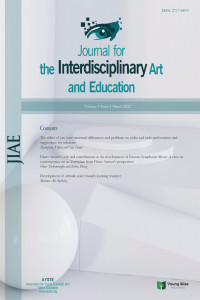A study on developing the evaluation scale of the polyphonic choir curriculum
A study on developing the evaluation scale of the polyphonic choir curriculum
___
- Albuz, A. (2004). Eğitim/ Müizik Eğitiminde Program Değerlendirme Yaklaşımlarına Genel Bir Bakış. Journal of Uludag University Faculty of Education, 13-18.
- Aygören, F. (2016). Eğitim programlarını Değerlendirmede I-Code Modelinin Geliştirilmesi. PhD Thesis . Balıkesir: Balıkesir University Institute of Social Sciences Department of Educational Sciences.
- Beyazkoç, M. (2021). Güzel Sanatlar Lisesi Temel Sanat Eğitimi Dersi Öğretim Programının Öğretmen Görüşlerine Göre İncelenmesi. Master Thesis . Samsun: Ondokuz Mayıs University Graduate Education Institute Fine Arts Education Department Painting Education.
- Bollen, KA (1990). Kovaryans yapı modellerinde genel uyum: İki tür örneklem büyüklüğü etkisi. Psychological bulletin, 107 (2), 256.
- Büyüköztürk, Ş., Kılıç Çakmak, E., Akgün, Ö. E., Karadeniz, Ş., & Demirel, F. (2020). Eğitimde Bilimsel Araştırma Yöntemleri. Ankara: PEGEM AKADEMİ.
- Chıld, D. (2006). The Essential of Factor Analysis (3th Ed.). London: Continuum.
- Ekiz, D. (2017). Bilimsel Araştırma Yöntemleri. Ankara: Anı.
- Fitzpatrick, J. L., Sanders, J. R., & Worthen, B. R. (2011). Program Evaluation Alternative Approaches and Practical Guidelines (4th Ed.). New Jersey.
- Fraenkel, J. R., Wallen, N. E., & Hyun, H. H. (2012). How To Desıng and Evaluate Research ın Education. (8th ed).
- Holter, JW (1983). Kovaryans yapılarının analizi: Uyum iyiliği indeksleri. Sosyolojik Yöntemler ve Araştırma , 11 (3), 325-344.
- Hu, LT ve Bentler, PM (1999). Kovaryans yapı analizinde uyum indeksleri için kesme kriterleri: Yeni alternatiflere karşı geleneksel kriterler. Structural equation modeling: a multidisciplinary journal, 6 (1), 1-55.
- İlhan, A. Ç., & Karabulut, Y. (2018). Anadolu Güzel Sanatlar ve Spor Liseleri Müzik Bölümlerindeki Program Değişiklikleri. Journal of Ankara University Faculty of Educational Sciences Volume: 51 Issue:3 , 101-125.
- Kalaycı, Ş. (2008). SPSS uygulamalı çok değişkenli istatistik teknikleri.(3rd Edition). Ankara: Asil Publication Distribution,
- Kaiser, H. F. (1974). An index of factorial simplicity. Psychometrika, 39, 31–36. (6043 citations as of 4/1/2016).
- Karakoç, F. Y., & Dönmez, L. (2014). Ölçek geliştirme çalışmalarında temel ilkeler. Tıp Eğitimi Dünyası, 13(40), 39-49
- Orçan, F. (2018). Açımlayıcı ve doğrulayıcı faktör analizi: İlk hangisi kullanılmalı? Journal of Measurement and Evaluation in Education and Psychology,9(4), 413-421.DOI: 10.21031/epod.394323
- Özdemir, S. M. (2009). Eğitimde Program Değerlendirme ve Türkiye'de Eğitim Programlarını Değerlendirme Çalışmalarının İncelenmesi. Yüzüncü Yıl University Journal of the Faculty of Education, 126-149.
- Shevlin, M., & Miles, J. N. (1998). Effects of sample size, model specification and factor loadings on the GFI in confirmatory factor analysis. Personality and Individual differences, 25(1), 85-90.
- Şahin, P. (2017). Güzel Sanatlar lisesi Piyano Öğretimi Sürecinin Öğretmen ve Öğrenci Görüşleri Çerçevesinde Değerlendirilmesi, Doctoral Thesis, Ankara: Gazi University Institute of Educational Sciences.
- Tavşancıl, E. (2002). Tutumların ölçülmesi ve SPSS ile veri analizi. Ankara: Nobel Publishing.
- Türkmen, E. F. (2020). Müzik Eğitiminde Öğretim Yöntemleri. Ankara: Pegem Akademi.
- Website Web 1: http://ogm.meb.gov.tr/meb_iys_dosyalar/2015_05/07092423_ogmokultanitim.pdf
- Yayın Aralığı: Yılda 4 Sayı
- Başlangıç: 2020
- Yayıncı: Genç Bilge Yayıncılık
Comparison of right-hand playing techniques used in flamenco guitar and baglama
A new model for the teaching violin to young learners
A study on developing the evaluation scale of the polyphonic choir curriculum
Gülay LAÇİN, İlknur ÖZAL GÖNCÜ
Examination of the progressive aspects of the piano etude genre of Russian composers
